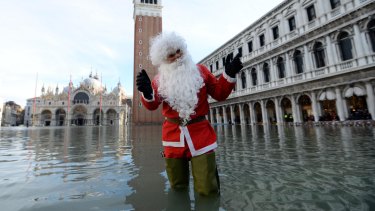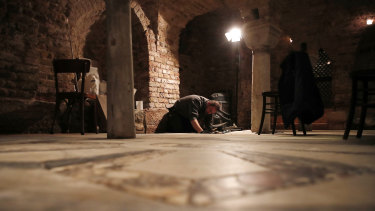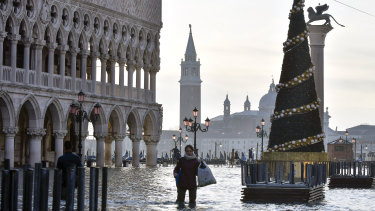Home » World News »
‘Invisible’ flood damage to St Mark’s Cathedral totals millions
Venice: "Every stone is a treasure," says the technical director of St Mark's Basilica's vestry board, indicating the prized gold-leaf mosaics overhead, the inlaid stone pavement and the marble clad walls of the 923-year- old masterpiece.
And many are vulnerable to the infiltration of sea water during the lagoon city's ever-higher tides.
A man dressed as Santa Claus poses in St Mark’s Square in Venice, Italy, during a high tide of 1.44 metres on Monday.Credit:ANSA/AP
Constructed atop two previous churches on a site that early Venetians believed was among the most secure in the Canal City, St Mark's Basilica suffered at least €5 million ($8 million) in damage during last month's devastating great tides. The first, on November 12, was the highest in 53 years, followed by two above 1.5 metres, a series of severe inundations never before recorded.
Though the highest was seven centimetres less than the famed 1966 flood of 1.94 metres, St Mark's chief caretaker, Carlo Alberto Tesserin, said, "We say this was the worst."
Unlike other natural disasters, like, say, an earthquake that leaves images of collapsed bell towers and fallen walls, fresh damage from the Venice floods is so far not visible to the naked eye.
"Someone who comes to Venice to see the high water, and who goes to St. Mark's Square the next day, sees tables in the square, says, 'Hey, look, the orchestra is playing. Nothing is wrong here.' While, in reality, what is hidden, is everything we have verified in these days," said Tesserin, who submitted the damage estimate earlier this month to city and national officials.
A man works in the St Mark’s Basilica crypt in Venice, Italy, last week.Credit:AP
Peaking at 1.87 metres above sea level, last months’ great tide was accompanied by wind gusts of up to 120/kph that pushed the waters even higher, flooding through the windows in St Mark's crypt of patriarchs. The gale-force gusts buffeted the Basilica's domes, tearing away lead tiles, Tesserin said. Both floodwaters entering from the windows and the ripping away of lead tiles were firsts in the Basilica's history.
Witnesses reported waves in St Mark's Square never before seen. The Venice Patriarch told a news conference that they were like waves at the seashore, a first in his experience despite having witnessed "the piazza full of water many times."
"It was the first time that I was truly afraid," said Giuseppe Maneschi, the vestry board technical director. The assault was three-pronged: Water was entering from the piazza, through the narthex; from the crypt windows, while also pushing up from below the Basilica. Maneschi worked with others to move precious objects, like a standing crucifix, higher.
Venice is facing more intense floods, while it battles to recover from the exceptional high tide that hit it in November, causing massive damages. Credit:AP
Tesserin said that they believe the water flooding in from the crypt windows was actually a blessing in disguise, creating pressure that prevented the lagoon rising beneath the Basilica from shattering those concrete barriers, called "vasca," or Italian for "tub."
Workers last week were removing the crypt's marble flooring, which lies 20 centimetres below sea level, to observe whether there are indeed cracks allowing water to infiltrate.
The Venice landmark includes 130 different kinds of marble — some which no longer exist — that tell the story of ancient conquests. Treasures, like the Madonna Nicopeia that accompanied Byzantine armies to battle, populate every corner, more than the average admirer can possibly assimilate in one visit. But the real prize, Tesserin notes, are its 8500 square metres of mosaics.
St Mark’s chief caretaker, Carlo Alberto Tesserin.Credit:AP
It may seem crazy to a modern eye that such a precious Basilica was established at Venice's lowest point. The piazza outside floods at 80 centimetres, and water passes the narthex into the church at 88 centimetres (reinforced from a previous 65 centimetres), floods the Zen Chapel at 1.2 metres and the baptistery goes under at 1.3 metres.
But Tesserin said that when the third Basilica was built, "it was in the position that was considered most safe." It has become vulnerable with the passage of centuries, due to the subsidence, or sinking of the land, accompanied by a sea level that has risen 12 centimetres over the last 50 years, and climate change, which has made forecasting high tides in Venice more difficult.
Damage can be seen on the bottom of a column of precious Aquitaine marble in the narthex. The capitals are carved with images of lions and eagles, indicating they are of imperial origin and not religious, and therefore believed to have been sacked from Constantinople during the fourth Crusade, Maneschi said. Analysis only this year indicates that the capitals were made even more ornate by gold leaf covering and lapis lazuli inserts – which have long disappeared.
The base of one of the decorative columns is badly corroded. But the dark Aquitaine marble prized by ancient civilisations can no longer be found.
"The day it falls, we will replace it with another marble. But as long as it resists, we will keep this," Maneschi said.
AP
Source: Read Full Article






